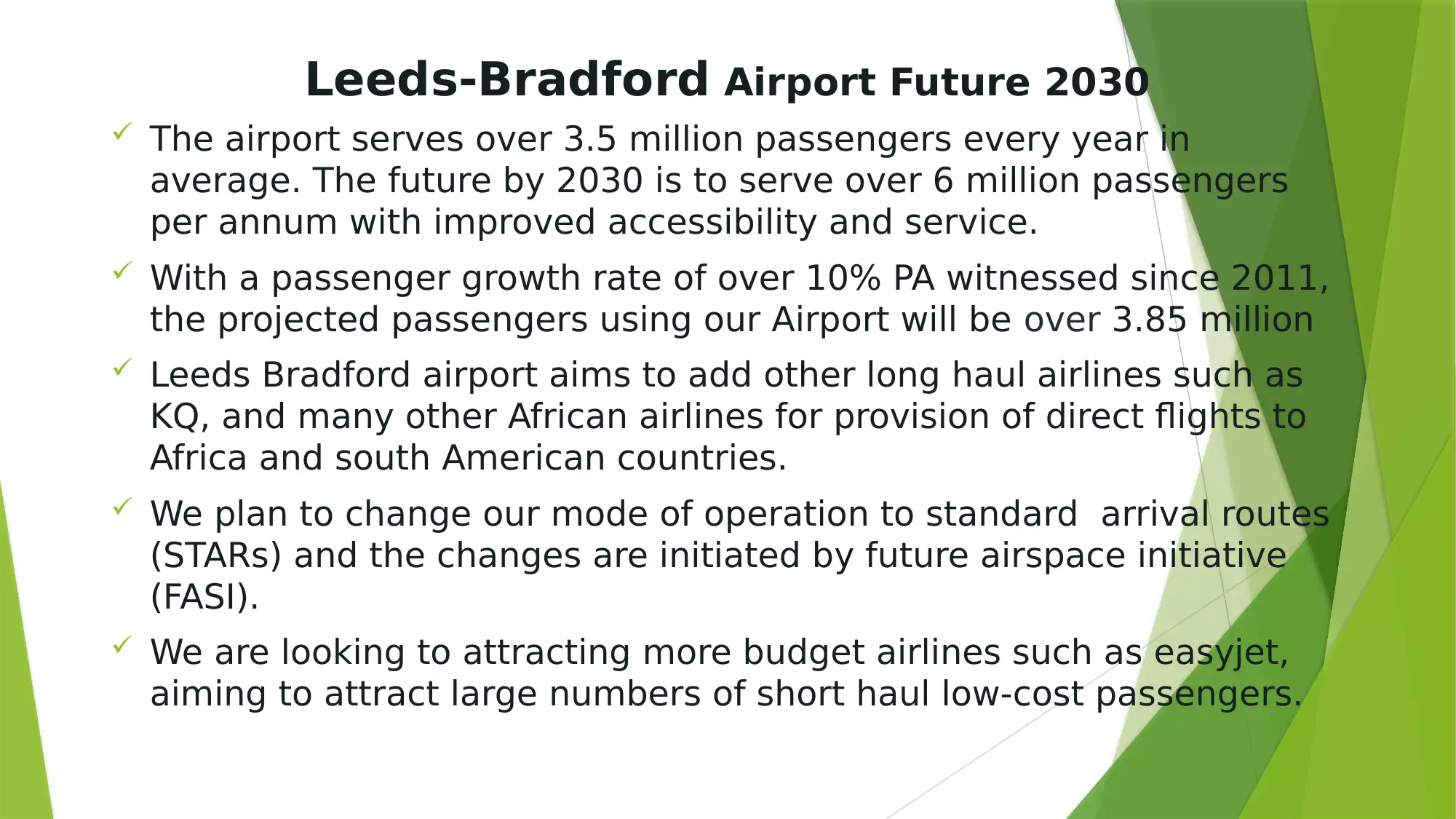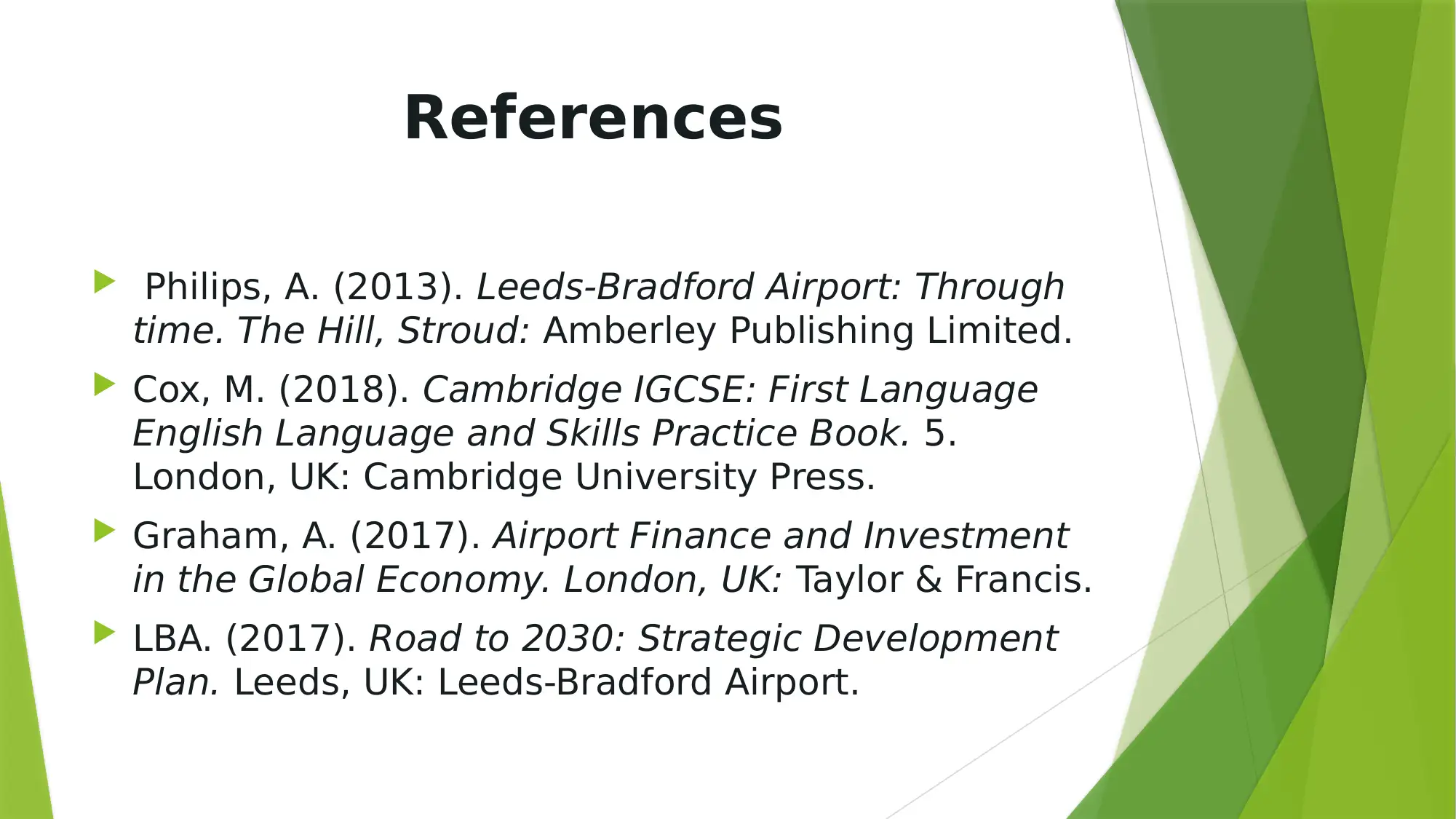Analysis of Leeds-Bradford Airport's Strategic Development Plan
VerifiedAdded on 2023/04/17
|6
|896
|74
Report
AI Summary
This report outlines Leeds-Bradford Airport's (LBA) strategic development plan with a vision for the future until 2030. Currently serving over 3.5 million passengers annually, LBA aims to increase this number to over 6 million through improved accessibility and services. Key initiatives include attracting more airlines, upgrading terminal facilities, building a new runway, improving railway connections and road access, and expanding parking and retail services. The plan also emphasizes waste management, noise mitigation, pollution control, and community engagement. The strategic development is expected to create employment opportunities, stimulate the local economy, and enhance LBA's competitive position among UK airports, aspiring to reach the levels of Manchester and Liverpool airports by focusing on budget airlines and increased passenger numbers.

Leeds-Bradford Airport
Leeds Bradford Airport is located at Yeadon, in the City of
Leeds Metropolitan District in West Yorkshire, England,
about 7 miles northwest of Leeds city center itself, and
about 9 miles from Bradford city center (Philips, 2013).
Its catchment area contains 5.3m people, 2.9m of whom
live less than one hour from the airport.
There are numerous routes served by the Airport
including; Alicante (ALC), Almeria (LEI), Antalya (AYT),
Barcelona (BCN), Bodrum (BJV), Corfu (CFU) and many
more.
Some of the major flights include; Thomson fly, Air
Mauritius, and EasyJet.
The airport has created 2 350 direct jobs and contributed
to £ 336 million to the local economy.
Some of the aircraft models now based in our airport
include Boeing 737-800,Douglus Dakota IV with plans to
operate Boeing 737-Max underway.
Leeds Bradford Airport is located at Yeadon, in the City of
Leeds Metropolitan District in West Yorkshire, England,
about 7 miles northwest of Leeds city center itself, and
about 9 miles from Bradford city center (Philips, 2013).
Its catchment area contains 5.3m people, 2.9m of whom
live less than one hour from the airport.
There are numerous routes served by the Airport
including; Alicante (ALC), Almeria (LEI), Antalya (AYT),
Barcelona (BCN), Bodrum (BJV), Corfu (CFU) and many
more.
Some of the major flights include; Thomson fly, Air
Mauritius, and EasyJet.
The airport has created 2 350 direct jobs and contributed
to £ 336 million to the local economy.
Some of the aircraft models now based in our airport
include Boeing 737-800,Douglus Dakota IV with plans to
operate Boeing 737-Max underway.
Paraphrase This Document
Need a fresh take? Get an instant paraphrase of this document with our AI Paraphraser

Leeds-Bradford Airport Future 2030
The airport serves over 3.5 million passengers every year in
average. The future by 2030 is to serve over 6 million passengers
per annum with improved accessibility and service.
With a passenger growth rate of over 10% PA witnessed since 2011,
the projected passengers using our Airport will be over 3.85 million
Leeds Bradford airport aims to add other long haul airlines such as
KQ, and many other African airlines for provision of direct flights to
Africa and south American countries.
We plan to change our mode of operation to standard arrival routes
(STARs) and the changes are initiated by future airspace initiative
(FASI).
We are looking to attracting more budget airlines such as easyjet,
aiming to attract large numbers of short haul low-cost passengers.
The airport serves over 3.5 million passengers every year in
average. The future by 2030 is to serve over 6 million passengers
per annum with improved accessibility and service.
With a passenger growth rate of over 10% PA witnessed since 2011,
the projected passengers using our Airport will be over 3.85 million
Leeds Bradford airport aims to add other long haul airlines such as
KQ, and many other African airlines for provision of direct flights to
Africa and south American countries.
We plan to change our mode of operation to standard arrival routes
(STARs) and the changes are initiated by future airspace initiative
(FASI).
We are looking to attracting more budget airlines such as easyjet,
aiming to attract large numbers of short haul low-cost passengers.

Airport planned projects
Plans to seek permission for development of terminal and extension or upgrade existing
one to cater for the number of flights, upgrade terminal baggage technology and offer
beverages by upgrading terminal lounges.
Plans to introduce simplified apron layouts to cater for short journey aircrafts.
Proposal to lease out and increase number of official taxis to private investors in order
to drop passengers directly at terminals and upgrade taxi parking areas
Plans to build new runway to cater for increased number flights per day and cater for
expected changes of standardizing airport operations.
Proposal to improve direct railway connections such as proposed construction of
Parkway station to cater for increasing number of passengers.
Construction of a new access road to link both major highways A65 and A68.
Working with authorities in developing good public transport system to improve
passenger accessibility to the airport.
Plans to develop a new car park to cater for increased number of passengers.
The airport is planning to build more hotels, restaurants and retail services by allowing
private investors to invest in develops kiosks and other facilities.
Plans to seek permission for development of terminal and extension or upgrade existing
one to cater for the number of flights, upgrade terminal baggage technology and offer
beverages by upgrading terminal lounges.
Plans to introduce simplified apron layouts to cater for short journey aircrafts.
Proposal to lease out and increase number of official taxis to private investors in order
to drop passengers directly at terminals and upgrade taxi parking areas
Plans to build new runway to cater for increased number flights per day and cater for
expected changes of standardizing airport operations.
Proposal to improve direct railway connections such as proposed construction of
Parkway station to cater for increasing number of passengers.
Construction of a new access road to link both major highways A65 and A68.
Working with authorities in developing good public transport system to improve
passenger accessibility to the airport.
Plans to develop a new car park to cater for increased number of passengers.
The airport is planning to build more hotels, restaurants and retail services by allowing
private investors to invest in develops kiosks and other facilities.
⊘ This is a preview!⊘
Do you want full access?
Subscribe today to unlock all pages.

Trusted by 1+ million students worldwide

Impact to Stakeholders
Proper waste management measures such outsourcing of recycling
facilities with the aim of recycling up to 98% of wastes produced by
aircrafts and within the airport.
Measures put in place in mitigation and management of noise. They
include plan to restrict airport operations to handle aircrafts which are
quitter. Also restricting night time flights.
Improving and constructing proper drainage to cater for surface water,
putting u measures in ensuring the ecology of catchment area is
conserved.
Improving facilities monitoring pollution to ensure early and proper action
plan.
Improving ways of reducing air pollution and monitoring air quality in
partnership with the government.
The Leeds city council agreed to a decision to allow the airport
management to implement this strategic development which enhance
their development plan of making the city employment opportunities hub.
Proper waste management measures such outsourcing of recycling
facilities with the aim of recycling up to 98% of wastes produced by
aircrafts and within the airport.
Measures put in place in mitigation and management of noise. They
include plan to restrict airport operations to handle aircrafts which are
quitter. Also restricting night time flights.
Improving and constructing proper drainage to cater for surface water,
putting u measures in ensuring the ecology of catchment area is
conserved.
Improving facilities monitoring pollution to ensure early and proper action
plan.
Improving ways of reducing air pollution and monitoring air quality in
partnership with the government.
The Leeds city council agreed to a decision to allow the airport
management to implement this strategic development which enhance
their development plan of making the city employment opportunities hub.
Paraphrase This Document
Need a fresh take? Get an instant paraphrase of this document with our AI Paraphraser

Summary
We believe that the growth and development of Leeds-Bradford Airport is underpinned by
engaging the local community, stakeholders and the relevant authorities. Because it is only
through open and valuable engagements and partnerships of above named parties will the airport
realize the aspects of this strategic plan.
Improving the infrastructure and streamlining operations of the airport will at the end serve a
larger purpose including easing traffic congestion, better services and facilities to the local
community, creation of employment opportunities and revolutionizing airport operations all over
the world (Cox, 2018).
Leeds-Bradford Airport has been for competing with top rated airports in the UK and the world
thus this strategic will only serve to put its image in the world map of aviation industry.
LBA is still behind giant airports in the UK such as Liverpool and Manchester airports and in terms
of total number of passenger and total flights per year. In 2018 LBA served over 4 million
passenger while operating over 38000 flights while Manchester and Liverpool airports served 28
million and 5 million respectively. With this proposed strategic development plan LBA sets
achievable target of getting to the levels of Manchester, Liverpool and Newcastle and maybe
surpassing them.
This favours us because our plan in operating budget aircrafts will bring cheaper flights
and thus increased number of passengers.
We believe that the growth and development of Leeds-Bradford Airport is underpinned by
engaging the local community, stakeholders and the relevant authorities. Because it is only
through open and valuable engagements and partnerships of above named parties will the airport
realize the aspects of this strategic plan.
Improving the infrastructure and streamlining operations of the airport will at the end serve a
larger purpose including easing traffic congestion, better services and facilities to the local
community, creation of employment opportunities and revolutionizing airport operations all over
the world (Cox, 2018).
Leeds-Bradford Airport has been for competing with top rated airports in the UK and the world
thus this strategic will only serve to put its image in the world map of aviation industry.
LBA is still behind giant airports in the UK such as Liverpool and Manchester airports and in terms
of total number of passenger and total flights per year. In 2018 LBA served over 4 million
passenger while operating over 38000 flights while Manchester and Liverpool airports served 28
million and 5 million respectively. With this proposed strategic development plan LBA sets
achievable target of getting to the levels of Manchester, Liverpool and Newcastle and maybe
surpassing them.
This favours us because our plan in operating budget aircrafts will bring cheaper flights
and thus increased number of passengers.

References
Philips, A. (2013). Leeds-Bradford Airport: Through
time. The Hill, Stroud: Amberley Publishing Limited.
Cox, M. (2018). Cambridge IGCSE: First Language
English Language and Skills Practice Book. 5.
London, UK: Cambridge University Press.
Graham, A. (2017). Airport Finance and Investment
in the Global Economy. London, UK: Taylor & Francis.
LBA. (2017). Road to 2030: Strategic Development
Plan. Leeds, UK: Leeds-Bradford Airport.
Philips, A. (2013). Leeds-Bradford Airport: Through
time. The Hill, Stroud: Amberley Publishing Limited.
Cox, M. (2018). Cambridge IGCSE: First Language
English Language and Skills Practice Book. 5.
London, UK: Cambridge University Press.
Graham, A. (2017). Airport Finance and Investment
in the Global Economy. London, UK: Taylor & Francis.
LBA. (2017). Road to 2030: Strategic Development
Plan. Leeds, UK: Leeds-Bradford Airport.
⊘ This is a preview!⊘
Do you want full access?
Subscribe today to unlock all pages.

Trusted by 1+ million students worldwide
1 out of 6
Related Documents
Your All-in-One AI-Powered Toolkit for Academic Success.
+13062052269
info@desklib.com
Available 24*7 on WhatsApp / Email
![[object Object]](/_next/static/media/star-bottom.7253800d.svg)
Unlock your academic potential
Copyright © 2020–2025 A2Z Services. All Rights Reserved. Developed and managed by ZUCOL.





